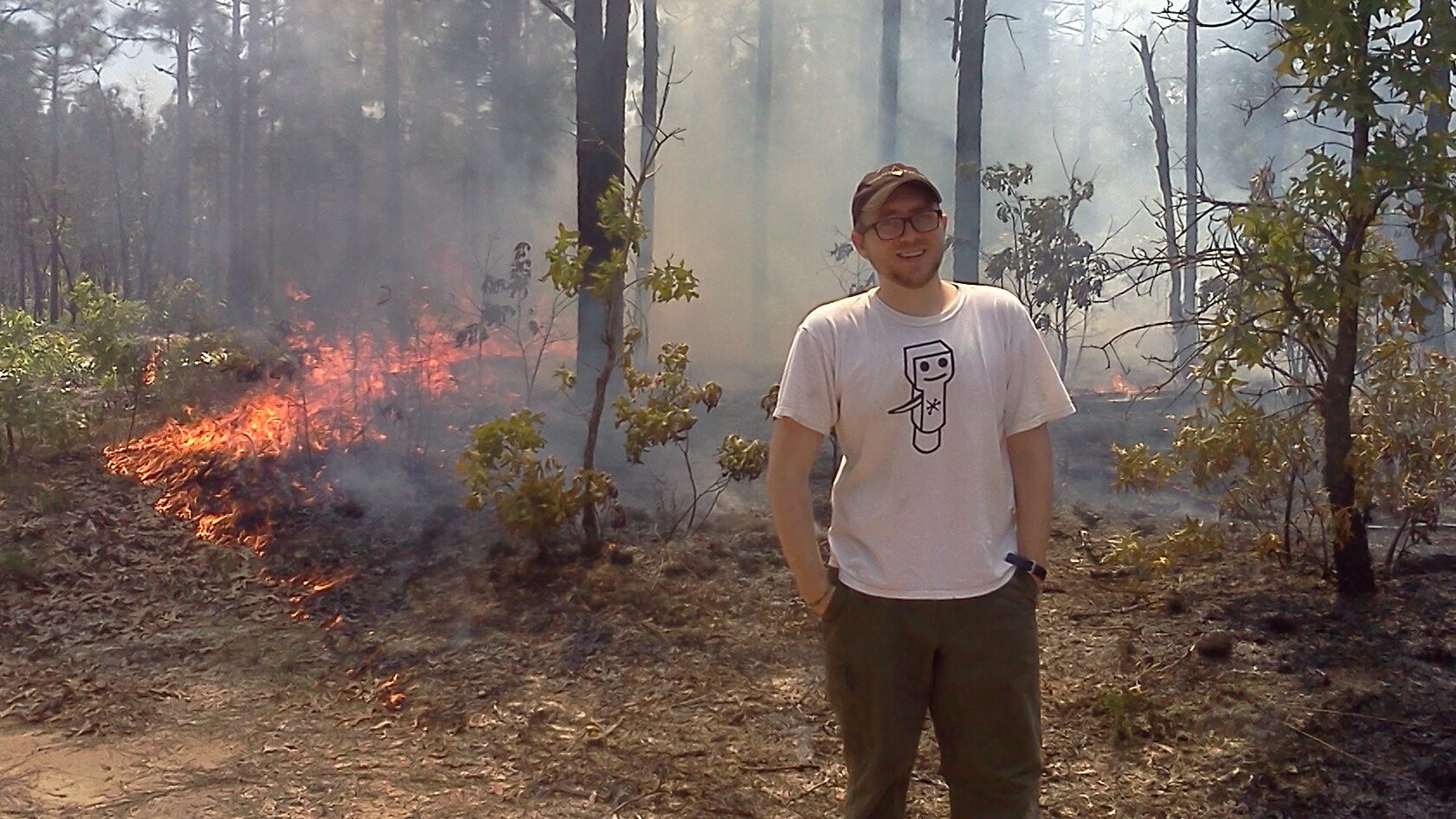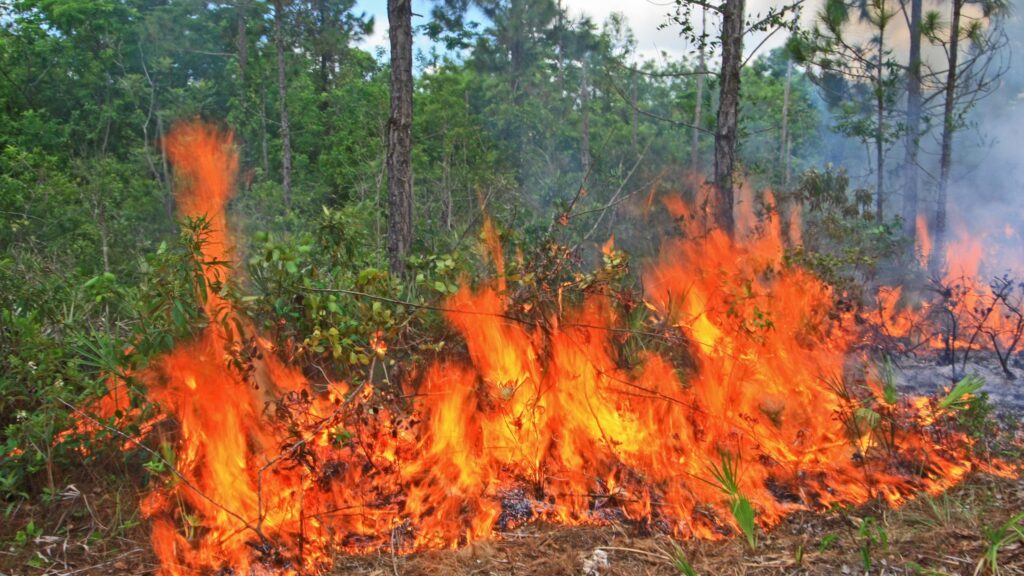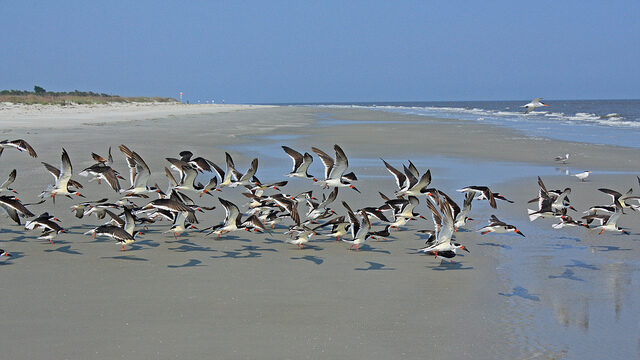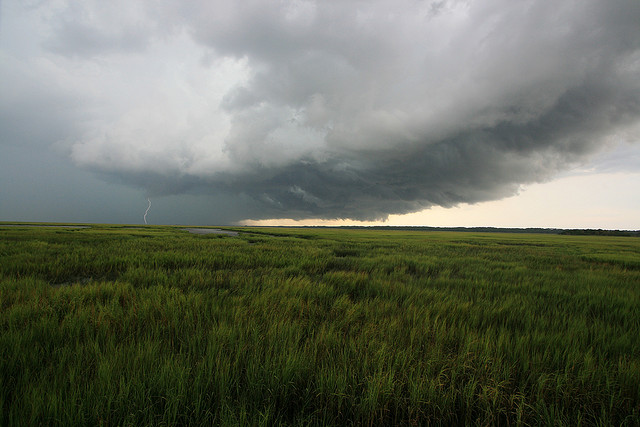Researcher Spotlight – Michael Just

2013-2014 Global Change Fellow
PhD Student, Department of Plant and Microbial Biology
Advisor: Dr. William Hoffman, Department of Plant and Microbial Biology
Every year the SE Climate Science Center funds a cohort of Global Change Fellows. They represent numerous disciplines across NC State University. Here is an example of the applied research being conducted by 2014 Fellow, Michael Just, who in the wake of a changing climate is thinking about how his research can benefit those needing to make conservation management decisions.
What are you currently working on?
My dissertation work falls under the broad classification of fire ecology. Wildfires are more than just chaotic destruction. They also promote healthy habitats with diverse plant and animal life in certain ecosystems. Fire is one of a number of reoccurring disturbances (e.g. flooding, hurricanes, etc.) that shape ecosystems on earth. Specifically, I study the relationship between fire, vegetation, and microclimate in savanna ecosystems. What makes this relationship interesting is that it is not linear, but instead results in a feedback, where fire influences what plants can grow and plants, in turn, influence the behavior of fire (e.g. by modulating microclimate). This relationship can be strong, but should not be considered absolute. To date scientists are still studying this feedback to determine the conditions that let fires beget healthy landscapes, instead of disrupting them. For example, changes in fire frequency might unsettle this feedback and even seemingly small changes might change the integrity of the ecosystem. I am examining this feedback’s capacity to withstand possible future global climate changes and predict its continued ability to maintain ecosystem characteristics. In my free time I’ve been working on other projects even more directly related humans, such as exploring the biogeography of human diseases.

What does your work using SDM in the Gulf Coast entail?
While a Global Change Fellow with the Southeast Climate Science Center (SECSC) I had the opportunity to take an Introductory Structure Decision Making (SDM) course at the National Conservation Training Center, which exposed me to SDM and left me wanting to learn more. I was fortunate that the fellowship provided opportunities to further develop my SDM skills. I was provided with the opportunity to serve as an apprentice SDM coach (coaches: Mitch Eaton, James Lyons, and Conor McGowan) for a group focused on decisions concerning the conservation of birds along the coast of the Gulf of Mexico. We have met several times and during these meetings we have been able to refine the decision problem and the approaches/tools used to help make the decision, which was necessary given the scope of the decision problem (e.g. many taxa, large spatial extent, etc.). The opportunity to meet with the same group on several occasions has been very useful as it has allowed me to witness the evolution of the group’s decision problem and develop SDM skills concomitantly. I also had the opportunity to act as an assistant coach for a beaver management decision problem in August 2014 that was a direct result of my work with Gulf Coast bird group.

What kind of managers might benefit from your research and how might a decision-maker use your science to make more informed decisions?
Broadly, understanding what controls flammability between pyrogenic (readily flammable, fire-prone) and pyrophobic (reluctantly flammable, fire-less) communities should prove very valuable for those making management decisions surrounding these communities. Ultimately, the transition from flammable to inflammable maintains distinct ecosystems and the species and processes they harbor. If we know more about why fires stop where they do, we can make more informed decisions about management issues. An example question might be, could we prescribe less frequent fire while maintaining our communities of interest? Knowing how fires, vegetation, and microclimate interact should shed light on such an issue. More specifically, my dissertation research should benefit land managers within the Carolina Sandhills (e.g. Ft. Bragg). For example, Ft. Bragg’s current prescribed fire program was implemented to benefit the federally-endangered red-cockaded woodpecker via its habitat preference for old longleaf pines. If managers wanted to consider changing current fire management, knowing where fires stop would prove useful as longleaf pines depend on frequent fires as they are shade intolerant.
What is your favorite paper that you have written? Why?
To date I have been an author on five peer-reviewed articles and I’ve been the primary author on one, which was side-project to my dissertation. That paper, Global biogeographic regions in a human-dominated world: the case of human diseases, began in a working-group style graduate class (Human Biogeography–taught by Rob Dunn) here at NCSU. It was a great experience to work with people from different disciplines (plant biology, biology, biomathematics, and anthropology) on the same research question, where we all had the opportunity to apply our expertise to a question outside of our main area of work. It felt like a great example of science at work, ask a question, attack it from multiple angles, and then publish. Read the paper here.
What is the most unusual “tool” you use in your research?
While I do use plenty of meteorological sensors (e.g. anemometers, soil moisture sensors, rain gauges, etc.) I think the most unusual tool I use in my research might be temperature-indicating paints. They allow me to record the maximum fire temperature for the fires that burn my research sites. They are sold in packaging very similar to nail polish, and I apply them to aluminum tags that are positioned at my site before fires. After fire they turn from matte to glossy if a temperature threshold was met.
Where did you grow up? What was the ecological environment like around you when you were growing up?
I grew up in the suburbs of Chicago, Illinois and while being a very developed landscape, the neighborhoods I lived in were old enough to have mature trees. Additionally, the Cook County Forest Preserve District provided opportunity for building-less outdoor enjoyment. However, I believe my interest in the ecological environment was initially fostered by two distinct experiences. One was my grandfather’s dairy farm in central Wisconsin, which served as the most ‘natural’ place I knew as a child. It provided ample opportunities to be outdoors, including the time spent in both row crops and woodlands, and to think about the ‘outside’. Second, the content of Weekly Readers during grade school was rich with environmental science topics, such as recycling and concern for tropical deforestation that held my attention better than other topics. While these experiences may have been a bit obtuse, they allowed my adolescent ecological concern to grow into enjoyment of the natural environment and a career path that allows me to remain nearly as quizzical as then.
What is the threat of global change that you are the most concerned about?
I am most concerned about the potential shifts in climate towards extreme events. For example, in some locations the total annual precipitation might not be projected to deviate much from current values, but when the precipitation arrives it might. This concerns me when I think about fire-adapted systems. For example, the savanna where I conduct my dissertation research typically has low intensity fires, and precipitation arrives rather evenly throughout the year. If more distinct wet and dry season were a result of global change, I’d be concerned about the possibilities of more intense fire from prolonged precipitation absences.
